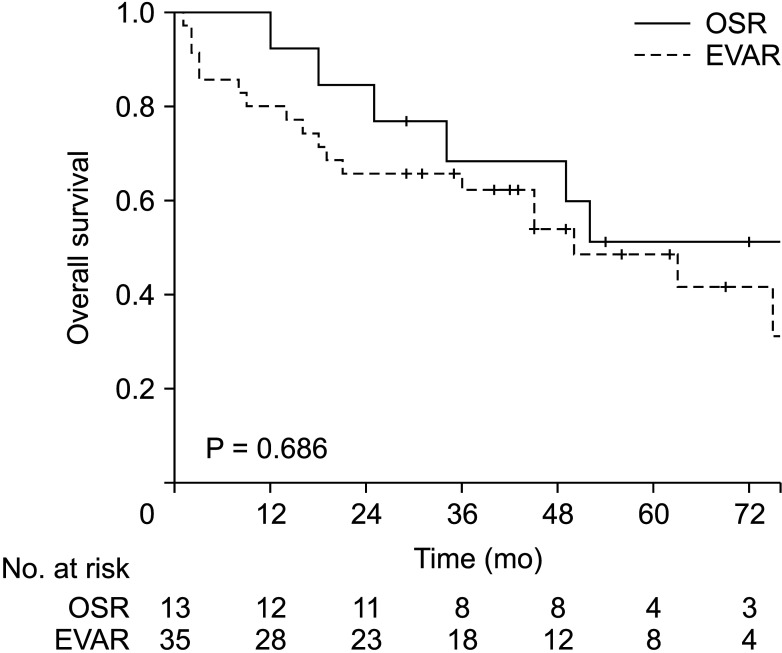Ann Surg Treat Res.
2022 Dec;103(6):372-377. 10.4174/astr.2022.103.6.372.
Similar long-term outcomes between endovascular aneurysm repair and open surgical repair for abdominal aortic aneurysms in octogenarian patients: a single-center study
- Affiliations
-
- 1Division of Vascular Surgery, Department of Surgery, Asan Medical Center, University of Ulsan College of Medicine, Seoul, Korea
- 2Department of Radiology, Asan Medical Center, University of Ulsan College of Medicine, Seoul, Korea
- KMID: 2536913
- DOI: http://doi.org/10.4174/astr.2022.103.6.372
Abstract
- Purpose
Endovascular aneurysm repair (EVAR) has lower perioperative mortality and morbidity rates and shorter hospital stays when compared to open surgical repair (OSR) in octogenarian patients. However, its long-term results remain unclear. Hence, we aimed to analyze and compare the long-term outcomes of OSR and EVAR in this aging population.
Methods
This single-center, retrospective, observational study analyzed the data of patients older than 80 years who underwent primary repair of an abdominal aortic aneurysm (AAA) between 2011 and 2016 in our hospital. The primary outcomes were in-hospital complications and 30-day mortality, while the secondary outcomes included all-cause mortality and reintervention rate.
Results
Among the 48 patients with elective AAA repair, 13 underwent OSR and 35 underwent EVAR. In-hospital complications occurred in 10 patients (20.8%), 5 for OSR (38.5%) and 5 for EVAR (14.3%) with no significant difference between the groups (P = 0.067). In the OSR group, pulmonary complications were the most common events; in the EVAR group, 2 patients had ischemic colitis diagnosed with sigmoidoscopy and recovered by conservative treatment. The 1- and 5-year survival rates were 77.8% and 55.6% in the OSR group, and 66.0% and 54.9% in the EVAR group, respectively. The reintervention rate was 8.6% for the EVAR group; none of the OSR group were readmitted.
Conclusion
The difference in procedures did not affect patient survival. Therefore, OSR does not necessarily have a worse prognosis than EVAR. Individual risk stratification must be preceded before the selection of an appropriate treatment method.
Keyword
Figure
Reference
-
1. Speziale F, Ruggiero M, Sbarigia E, Marino M, Menna D. Factors influencing outcome after open surgical repair of juxtarenal abdominal aortic aneurysms. Vascular. 2010; 18:141–146. PMID: 20470684.2. Henebiens M, Vahl A, Koelemay MJ. Elective surgery of abdominal aortic aneurysms in octogenarians: a systematic review. J Vasc Surg. 2008; 47:676–681. PMID: 18207352.3. Lange C, Leurs LJ, Buth J, Myhre HO. EUROSTAR collaborators. Endovascular repair of abdominal aortic aneurysm in octogenarians: an analysis based on EUROSTAR data. J Vasc Surg. 2005; 42:624–630. PMID: 16242543.4. Brewster DC, Cronenwett JL, Hallett JW Jr, Johnston KW, Krupski WC, Matsumura JS, et al. Guidelines for the treatment of abdominal aortic aneurysms: report of a subcommittee of the Joint Council of the American Association for Vascular Surgery and Society for Vascular Surgery. J Vasc Surg. 2003; 37:1106–1117. PMID: 12756363.5. Ambler GK, Gohel MS, Mitchell DC, Loftus IM, Boyle JR. Audit and Quality Improvement Committee of the Vascular Society of Great Britain and Ireland. The Abdominal Aortic Aneurysm Statistically Corrected Operative Risk Evaluation (AAA SCORE) for predicting mortality after open and endovascular interventions. J Vasc Surg. 2015; 61:35–43. PMID: 24985535.6. Tang T, Walsh SR, Prytherch DR, Lees T, Varty K, Boyle JR, et al. VBHOM, a data economic model for predicting the outcome after open abdominal aortic aneurysm surgery. Br J Surg. 2007; 94:717–721. PMID: 17514694.7. Shahidi S, Schroeder TV, Carstensen M, Sillesen H. Outcome and survival of patients aged 75 years and older compared to younger patients after ruptured abdominal aortic aneurysm repair: do the results justify the effort? Ann Vasc Surg. 2009; 23:469–477. PMID: 19136232.8. Huber TS, Carter JW, Carter RL, Seeger JM. Patency of autogenous and polytetrafluoroethylene upper extremity arteriovenous hemodialysis accesses: a systematic review. J Vasc Surg. 2003; 38:1005–1011. PMID: 14603208.9. Hicks CW, Obeid T, Arhuidese I, Qazi U, Malas MB. Abdominal aortic aneurysm repair in octogenarians is associated with higher mortality compared with nonoctogenarians. J Vasc Surg. 2016; 64:956–965. PMID: 27364946.10. Lagergren E, Chihade D, Zhan H, Perez S, Brewster L, Arya S, et al. Outcomes and durability of endovascular aneurysm repair in octogenarians. Ann Vasc Surg. 2019; 54:33–39. PMID: 30244017.11. Scallan O, Novick T, Power AH, DeRose G, Duncan A, Dubois L. Long-term outcomes comparing endovascular and open abdominal aortic aneurysm repair in octogenarians. J Vasc Surg. 2020; 71:1162–1168. PMID: 31519509.12. Herman CR, Charbonneau P, Hongku K, Dubois L, Hossain S, Lee K, et al. Any nonadherence to instructions for use predicts graft-related adverse events in patients undergoing elective endovascular aneurysm repair. J Vasc Surg. 2018; 67:126–133. PMID: 28760581.
- Full Text Links
- Actions
-
Cited
- CITED
-
- Close
- Share
- Similar articles
-
- The Complications and Their Management after Endovascular Aneurysm Repair for the Treatment of Abdominal Aortic Aneurysms
- Novel Technique to Rescue a Folded Aortic Endograft during Endovascular Aneurysm Repair
- Endovascular Stent-Graft Placement and Secondary Intervention for Abdominal Aortic Aneurysm in a Patient who had a Previously Inserted Iliac Stent
- Endovascular Treatment of Abdominal Aortic Aneurysm
- Total Laparoscopic Abdominal Aortic Aneurysm Repair: A Case Report


